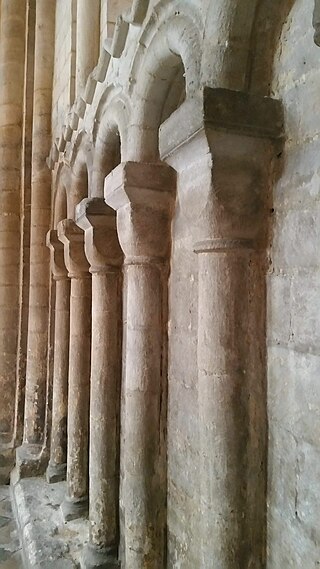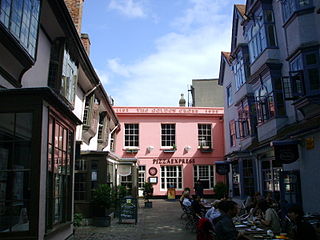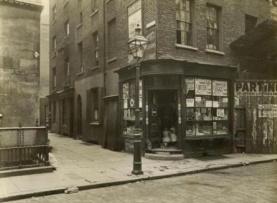
Cornmarket Street is a major shopping street and pedestrian precinct in Oxford, England that runs north to south between Magdalen Street and Carfax Tower.

An arcade is a succession of contiguous arches, with each arch supported by a colonnade of columns or piers. Exterior arcades are designed to provide a sheltered walkway for pedestrians; they include many loggias, but here arches are not an essential element. An arcade may feature arches on both sides of the walkway. Alternatively, a blind arcade superimposes arcading against a solid wall.

The Shambles is a historic street in York, England, featuring preserved medieval buildings, some dating back as far as the 14th century. The street is narrow, with many timber-framed buildings with jettied floors that overhang the street by several feet. It was once known as The Great Flesh Shambles, probably from the Anglo-Saxon Fleshammels, the word for the shelves that butchers used to display their meat. In 1885, thirty-one butchers' shops were located along the street, but none remain today.

Turl Street is a historic street in central Oxford, England.

The High Street in Oxford, England, known locally as the High, runs between Carfax, generally seen as the centre of the city, and Magdalen Bridge to the east.

Broad Street is a wide street in central Oxford, England, just north of the former city wall. The street is known for its bookshops, including the original Blackwell's bookshop at number 50, located here due to the University of Oxford. Among residents, the street is traditionally known as The Broad. On the street is a memorial paving for the Oxford Martyrs.

Queen Street is a pedestrianised shopping street in central Oxford, England. It is one-way for buses and taxis, two-way for cyclists outside main shopping hours, and forbidden for cars. It runs west from the centre of Oxford at Carfax. Here it adjoins Cornmarket Street to the north, the High Street continuing east, and St Aldate's to the south.

Kirkgate Market is a market complex on Vicar Lane in the city centre of Leeds, West Yorkshire, England. It is the largest covered market in Europe and a Grade I listed building. There are currently 800 stalls which attract over 100,000 visitors a week.

Golden Cross is a shopping arcade at 5 Cornmarket Street in central Oxford, England. The original structure on the site dates from 1193, when it was called Maugershall after the then owner, and consisted of shops with an inn on the upper storeys. The building structures now on the site date from the late 15th century, when they were used as a traditional coaching inn, as is clear from its layout and historical documents. The collection of historic buildings in the Golden Cross courtyard to the east off Cornmarket Street, one of Oxford's main shopping streets. Golden Cross is now used as Oxford's branch of Pizza Express. The courtyard is used as a thoroughfare which leads to the historic Covered Market and has been redeveloped as a small shopping centre, with upmarket shops, a branch of iGlasses Opticians, Holland and Barrett and a Chinese herbalist.

The Great Market Hall or Central Market Hall, Market Hall I is the largest and oldest indoor market in Budapest, Hungary. The idea of building such a large market hall arose from the first mayor of Budapest, Károly Kamermayer, and it was his largest investment. He retired in 1896 and participated in the opening ceremony on February 15, 1897.

The Clarendon Centre is a shopping centre in central Oxford, England, opened in 1984. The centre faces Cornmarket Street, and has other entrances onto Queen Street and Shoe Lane. The fascia onto Cornmarket Street is that of the Woolworths store which had, in a decision later criticised, replaced the Georgian Clarendon Hotel; it was discovered during demolition that medieval construction had been present within the hotel. The shopping centre was expanded in 2012–14. Major tenants include TK Maxx, H&M and Gap Outlet.

Market Street is a street in central Oxford, England, running east to west.

Boswells of Oxford was the largest independent family-run department store in Oxford, England. The store first traded in 1738 and was the second oldest family-owned department store in the world. It closed in 2020. The company did not use an apostrophe in its name, although others sometimes mistakenly do so.

Clare Market is a historic area in central London located within the parish of St Clement Danes to the west of Lincoln's Inn Fields, between the Strand and Drury Lane, with Vere Street adjoining its western side. It was named after the food market which had been established in Clement's Inn Fields, by John Holles, 2nd Earl of Clare. Much of the area and its landmarks were immortalised by Charles Dickens in The Old Curiosity Shop, The Pickwick Papers, Barnaby Rudge and Sketches by Boz.

Surrey Street Market is a street market located in Surrey Street, Croydon, south London. Records of a market on the site date back to the 13th century.

Cardiff Market, also known as Cardiff Central Market and as the Market Building, is a Victorian indoor market in the Castle Quarter of Cardiff city centre, capital city of Wales.

Newport Market is a traditional Victorian indoor market in Newport, South Wales. It is a Grade II-Listed building in the city centre, owned and operated by Newport City Council. The main structure, completed in 1889, is an early example of a large-span cast iron-frame building featuring a glazed barrel roof. The market re-opened in March 2022 as a multi-purpose food, retail and office space following a £5–6 million renovation.

Norwich Market is an outdoor market consisting of around 200 stalls in central Norwich, England. Founded in the latter part of the 11th century to supply Norman merchants and settlers moving to the area following the Norman conquest of England, it replaced an earlier market a short distance away. It has been in operation on the present site for over 900 years.

Stocks Market was a market in central London operating between 1282 and 1737 and for centuries was London's main retail meat and produce market.

The Pannier Market in Bideford in North Devon is a large covered Victorian pannier market together with the Butcher's Row of small artisan stalls running along the lower level of the Market. There has been a market on the site since 1675. Since 1989 it has been a Grade II listed building on the register of Historic England.




























